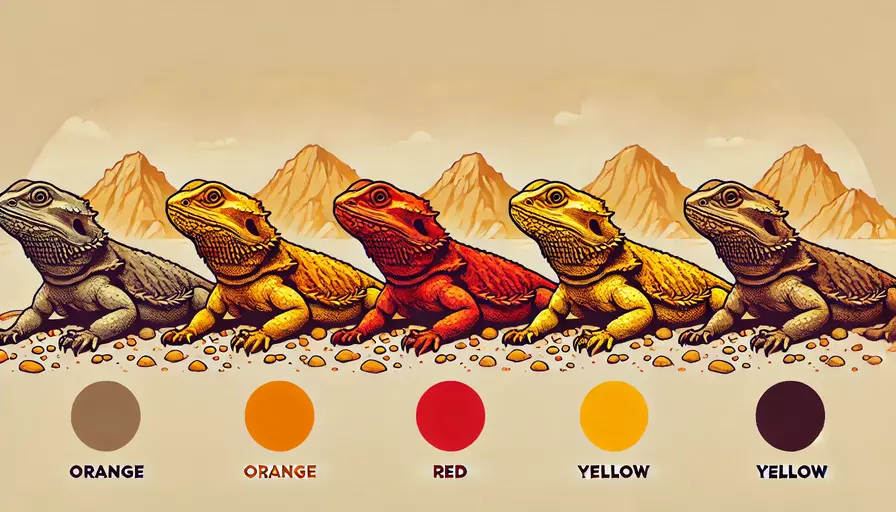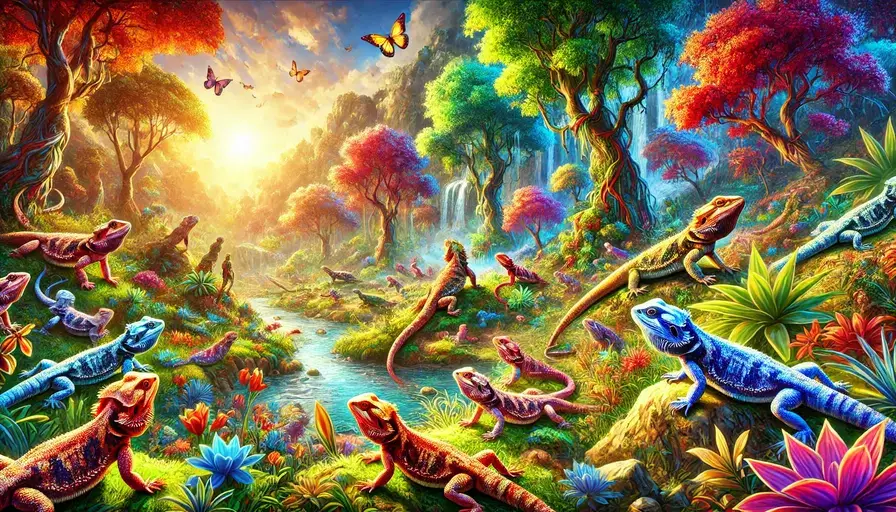Colored bearded dragon refers to the fascinating and diverse range of colors that these reptiles can exhibit, thanks to selective breeding and genetic variation. These stunning lizards come in an array of hues that make them a captivating choice for reptile enthusiasts.
In this guide, we’ll explore the rarest bearded dragon colors, whether they can be blue, and the various colors you might encounter, including the popular orange variant.
What is the Rarest Bearded Dragon Color?
When it comes to bearded dragons, some colors are rarer and more coveted than others. Understanding these rare colors helps in appreciating the diversity within the bearded dragon species.
Rarest Colors: Among the rarest bearded dragon colors are the vibrant blue and purple variants. These colors are not naturally occurring and result from extensive selective breeding. True blue bearded dragons are particularly rare, with most blue-toned dragons exhibiting only a hint of blue rather than a full blue coloration.
Genetic Factors: The rarity of these colors is due to the complexity of the genetic traits involved. Breeding for such unique colors requires specific genetic combinations and careful selection, making these dragons more difficult to produce and consequently more valuable.
Can Bearded Dragons Be Blue?
The concept of a blue bearded dragon is intriguing, but it’s important to understand the reality behind this color morph.
Natural Occurrence: In nature, bearded dragons do not have a true blue coloration. Their natural colors range from brown and orange to red and yellow. The blue coloration seen in some bearded dragons is the result of selective breeding and genetic manipulation.
Selective Breeding: Blue bearded dragons are produced through selective breeding practices. The blue coloration often appears as a faded or pastel blue rather than a vibrant, solid blue. These blue tones are achieved by crossing specific genetic lines to enhance the desired color traits.
Are There Different Colored Bearded Dragons?
Yes, colored bearded dragons come in a wide range of colors, each with its unique beauty and appeal.
Common Colors: Some of the most common colors include:
- Orange: One of the most popular colors, orange bearded dragons can range from a bright, fiery orange to a softer, pastel hue.
- Red: Red bearded dragons are highly sought after for their vibrant and striking appearance.
- Yellow: Yellow bearded dragons exhibit a range of hues from pale yellow to deep golden shades.
Color Morphs: In addition to these common colors, there are many morphs and variations, including translucent, leatherback, and hypo bearded dragons. Each morph can influence the overall appearance and color of the bearded dragon.

Can Bearded Dragons Be Orange?
Yes, bearded dragons can be orange, and this color is one of the most popular and recognizable among enthusiasts.
Variations of Orange: Orange bearded dragons come in various shades, from bright, vibrant oranges to softer, pastel tones. The intensity of the color can vary depending on the dragon’s lineage and the specific breeding practices used.
Popularity and Appeal: The orange coloration is favored for its striking and eye-catching appearance. This color is often achieved through selective breeding, and many breeders focus on enhancing the richness and depth of the orange hues in their dragons.
Caring for Your Colored Bearded Dragon
Regardless of the color, proper care is essential for maintaining the health and well-being of your bearded dragon. Here are some key care tips to ensure your colored bearded dragon thrives:
Habitat Setup
Enclosure Size: A spacious enclosure is necessary for your bearded dragon to thrive. A minimum of a 75-gallon tank is recommended for adults, with larger setups providing more space for exercise and enrichment.
Temperature and Lighting: Maintain a temperature gradient with a basking area of 95-105°F (35-40°C) and a cooler zone of 75-85°F (24-29°C). Provide UVB lighting to support calcium metabolism and overall health. Regularly check and replace UVB bulbs to ensure they are effective.
Substrate and Enrichment: Choose a safe substrate, such as reptile carpet or tile, to prevent ingestion issues. Add enrichment items like climbing branches, rocks, and hiding spots to mimic their natural environment and promote mental stimulation.
Diet and Nutrition for Colored Bearded Dragons
Balanced Diet: Provide a variety of live insects, fresh vegetables, and occasional fruits to meet your bearded dragon’s nutritional needs. Ensure insects are gut-loaded and dusted with calcium and vitamin supplements. Offer a mix of leafy greens and vegetables to provide a balanced diet.
Hydration: Provide fresh water daily and offer a shallow dish for soaking. Proper hydration is crucial for digestion and overall health.

Health Monitoring
Regular Check-Ups: Schedule regular veterinary check-ups to monitor your bearded dragon’s health and address any concerns related to diet, pooping, or general well-being.
Observing Changes: Keep an eye on any changes in your bearded dragon’s behavior, appearance, or pooping patterns. Early detection of issues can help prevent more serious health problems.
Additional Resources
For more information on bearded dragon care and related topics, explore these articles:
- Bearded Dragon Blue: The Stunning Truth Behind This Rare Morph
- Red Bearded Dragon: Captivating Beauty and Essential Care for Your Vibrant Pet
- Bearded Dragon Diet: What to Feed Your Pet for Optimal Health
Conclusion
The world of colored bearded dragons offers a vibrant and diverse range of hues that captivate reptile enthusiasts. While rare colors like blue are highly sought after, bearded dragons come in various stunning shades, including the popular orange. Understanding these colors and their rarity can help you appreciate the beauty of these unique reptiles. With proper care and attention, your colored bearded dragon will thrive and bring joy to your life.

